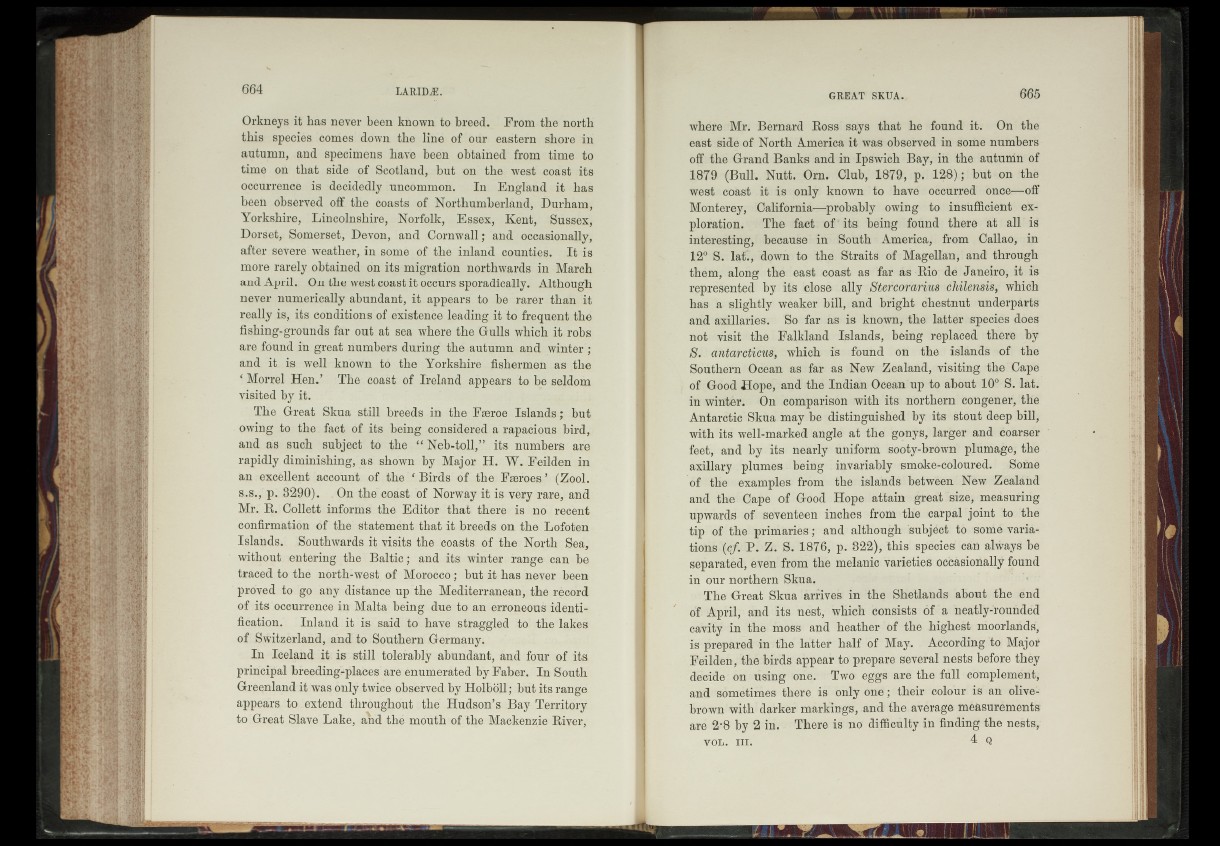
Orkneys it has never been known to breed; From the north
this species conies down the line of our eastern shore in
autumn, and specimens have been obtained from time to
time on that side of Scotland, but on the west coast its
occurrence is decidedly:uncommon. In England it has
héén observed off. the coasts of Northumberlandj Durham,
Yorkshire, Lincolnshire, Norfolk, . Essex, Kent, Sussex,
Dorset/; Somerset, Devon, and Cornwall; and occasionally,
after severe weather, in some j of the inland counties; It is
more rarely obtained on its migration northwards in March
and April., On the west coast it occurs sporadically. Although
never numerically abundant, it, appears to be rarer than Jit
really is, its conditionsOf existence leadingdt to frequentithe
fishing-grounds far out at sea where the ‘Gulls which it robs
are found in great numbers during' the autumn, and winter';
and it is well; known tó the Yorkshire fishermen.as the
‘Morrel Hen/ The*coast of Ireland appears to be seldom
yisited by it.
The Great Skua still breeds in the Faeroe Islands.; but
owing to the. fact of its being considered a rapacious- bird,
and as such subject’ to- the |f Neb-toll,fpits numbers are
rapidly diminishing, an showmby Major. H. W; .Feilden in
an exeéllent account .of: th e ' ‘ Birds' of the. Faeroes’ (Zool.
s,s.,' p. .8290). . On theJcoast of Norway ife is.vèry rare, and
Mr. R.‘C.ollett informs the Editor that, there1 is noJ'recent
confirmation of the’ statement: that "it-breeds on the, Lofoten
Islands/ ^Southwards it visits the .coasts of the- North Sea,
without .entering the Baltic.; and its. winter range can. be
traced to thé north?west, of- Morocco,;‘but i t has never been
proved to go any distance upJthé Mediterranean,, the record
of its occurrence in Malta being, due- to..an erroneous idenf%
fication. ‘Inland.it is said to .havé straggled 'to the lakes
of Switzerland, and to Southern- .Germany.
In Iceland lit; is . still tolerably abundant, and four of its
principal breeding^ places' are/mumerated.by Faber, In South
Greenland it was only twice obser-v§dby Holböil; .but its range
appeafs/to iextend throughout.the .Hudson’s sBay Territory
to Great Slave Lake, and thé. mduth'ofthe Mackenzie River,
where Mr. Bernard Ross says that he found it. On the
east side of North America it was observed in some numbers
off the Grand Banks and in Ipswich Bay, in the uutundn of
1879 (Bull. Nutt. Orn. Club, 1879, p. 128)-.; but on/tht
west coast it r is only known S to have occurred i once—off
Monterey, California—probably owing to insufficient exploration.
v. The “fact’ of "its being found there at all' is
interesting,’ because1 in South - America, from Callao, in
12Q S. laC, ‘down to the Straits, of Magellan,' and through
them, along the; east coast as far as Rio: de Janeiro; it is
represented by its which
has a slightly weaker bill, and bright chestnut undérparts
and auxiliaries. So far as is known, the latter ^specie's dees
net visit the .Falkland Islands, being replaced there by
8 . antarcticusij, which is;.;; found on the - islands of the
Southern Ocean as far as New Zealand, visiting the Cape’
of Good Hope, and the Indian Ocean up to aböutdöP'S. lat.
in winter. On comparison with its’ northern'“Congener, the
Antarctic’Skua may be distinguished? by its stout deep bill,
with its'well-marked angle at the ‘gqnyfc; larger: and? coarser
feet;, and ’by..its nearly* uniform sooty-brown plumage; the
axillary plumes. being/ invariably smoke-coloured1. ’ Some
o f the examples from the islands betwèen’New Zealand
and the Cape o f Good Hope attain great size, measuring
upwards of seventeen inches from ‘the carpal'joint to the
tip of theJprimaries; and although isubjéct tó somé variations
lfcj&£P. Z. S. 187fi, p. 822), this1 upêcies’ can always be
separated; èvedifrom the melanic varieties occasionally found
in our northern Skua.
-The Great Skua arrives.1 in the Shetlands about the énd
óf April, and Its nest, which consists- óf far neatly-founded
cavity in the moss? and heather of the highest' moorlafids,.
^prepared in the latter' half of May. According to- Major
Feilden, the birds appear to prepare several nests before thèy
decide - on using* rone: Two eggs are the full complement;
and sometiifies there, is only ondtheir'colour is-;an;-olive-
brown with; darker markings, and- the average méasuréments
arö ÉÉÉ by 2 in .. There is no difficulty in finding the nests*
vA i.‘III.’ 4 Q